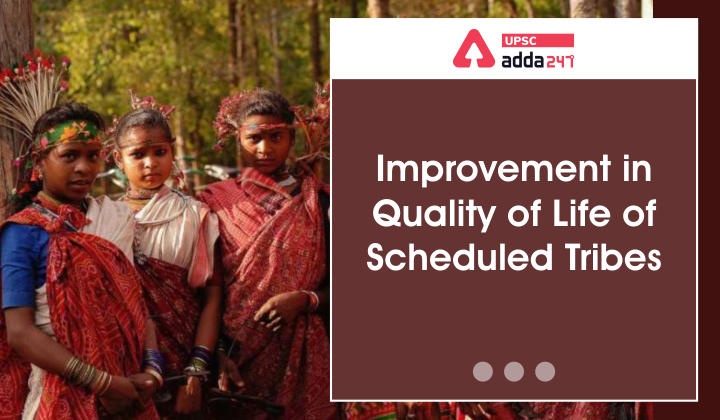Table of Contents
Scheduled Tribes: Relevance
- GS 2: Welfare schemes for vulnerable sections of the population by the Centre and States and the performance of these schemes.
Scheduled Tribes: Context
- Recently, Minister of State for Tribal Affairs has informed the Lok Sabha about steps taken so far for the development of the Scheduled Tribes in India that has led to improvement in their quality of life.
Improvements in living conditions of the Scheduled Tribes (STs)
Education
- Literacy rate for STs has improved from 47.1% in 2001 to 59% in 2011.
- Further, Periodic Labour Force Survey (PLFS) report (July 2019 – June 2020) reveals that literacy rate for STs increased to 70.1%.
- According to UDISE+ reports, Gross Enrolment Ratio (GER) for ST students at senior secondary (classes IX-X) level has increased from 62.4% in 2012-13 to 76.7% in 2019-20.
Health
- As per National Family Health Surveys (NFHS), in respect of Scheduled Tribes,
- Infant Mortality Rate has declined from 62.1 (2005-06) to 44.4 (2015-16);
- Under Five Mortality Rate has declined from 95.7 (2005-06) to 57.2 (2015-16),
- and Institutional Delivery has increased from 17.7% in 2005-06 to 68.0 % in 2015-16.
- Further, percentage of Underweight (weight-for age) ST children under age five years has declined from 54.5 in 2005-06 to 45.3 in 2015-16
Poverty
- Erstwhile Planning Commission estimated that percentage of ST people living below the poverty line in rural areas has declined from 62.3% in 2004-05 to 45.3% in 2011-12.
- Also, percentage of ST people living below the poverty line in urban areas has declined from 35.5% in 2004-05 to 24.1% in 2011-12.
Steps taken by government
Educational steps
- Eklavya Model Residential Schools (EMRS): The scheme of Eklavya Model Residential Schools (EMRSs) was introduced in the year 1997-98 to impart quality education exclusively to ST children.
- Strengthening Education among ST Girls in Low Literacy Districts: Scheme is exclusively for ST girls in 54 districts identified in the country, where the ST population is 25% or more and ST female literacy rate is below 35% or its fractions, as per 2001 Census.
- Pre-Matric and post Matric Scholarships to ST students
- National Overseas Scholarships for ST Candidates for Studying Abroad: The Scheme provides for financial assistance to selected students to pursue Post Graduation, PhD & Post-Doctoral study abroad.
- National Fellowship &Scholarship for Higher Education of ST students.
Other developmental steps
- Special Central Assistance to Tribal Sub-Scheme (SCA to TSS): Under scheme of Special Central Assistance to Tribal Sub-Scheme (SCA to TSS) 100% grants is provided to the State Governments for the development of STs.
- Grants under Article 275(1) of the Constitution: Grants are released to 26 States, having ST population for raising the level of Administration in Scheduled Areas and for the welfare of tribal people.
- Grant-in Aid to Voluntary Organizations working for the welfare of Scheduled Tribes: Under this, the Ministry funds projects in the fields of Education and Health, covering residential schools, non-residential schools, hostels, mobile dispensaries, ten or more bedded hospitals, etc.
- Development of Particularly Vulnerable Tribal Groups (PVTGs): The scheme of Development of PVTGs covers 75 identified PVTGs among Scheduled Tribes in 18 States and UT of Andaman & Nicobar-Islands.
- Mechanism for Marketing of Minor Forest Produce (MFP) through Minimum Support Price (MSP) & Development of Value Chain for MFP: This scheme was introduced by the Ministry of Tribal Affairs in the year 2013-14, to provide safety net and support to people belonging to Scheduled Tribes and other traditional forest dwellers whose livelihood depends on collection and selling of MFP.
Institutional steps
- Institutional Support for Development & Marketing of Tribal Products/Produce (Central Sector Scheme): The Tribal Cooperative Marketing Development Federation of India Limited (TRIFED) functions both as a service provider and market developer for tribal products. It markets tribal products through the network of its retail outlets ‘TRIBES INDIA’ in the country.
- National/State Scheduled Tribes Finance and Development Corporations (NSTFDC/STFDCS): National Scheduled Tribes Finance and Development Corporation (NSTFDC) is an apex organization set up in 2001, exclusively for economic development of Scheduled Tribes.
- Support to Tribal Research Institutes (TRIs): The Ministry extends support to the State Governments through the Scheme to set up new TRIs where it didn’t exist and to strengthen functioning of existing TRIs to carry out its core responsibility towards Research & Documentations, Training and capacity building, promotion of rich tribal heritage etc.



 TSPSC Group 1 Question Paper 2024, Downl...
TSPSC Group 1 Question Paper 2024, Downl...
 TSPSC Group 1 Answer key 2024 Out, Downl...
TSPSC Group 1 Answer key 2024 Out, Downl...
 UPSC Prelims 2024 Question Paper, Downlo...
UPSC Prelims 2024 Question Paper, Downlo...
